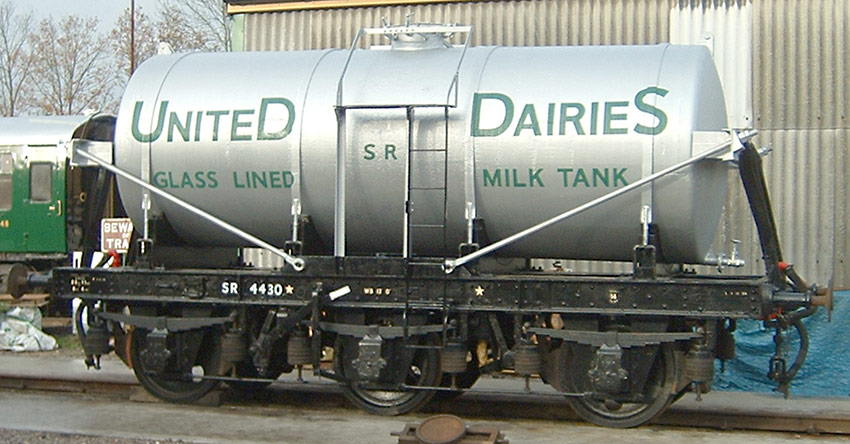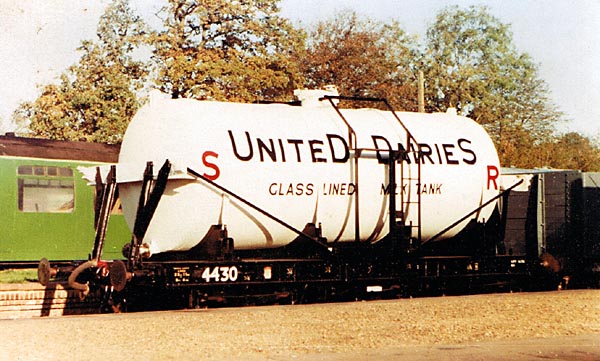Carriage & Wagon Dept -
Stock Lists: Carriages, Vans, Wagons & Multiple Units -
C&W News
SR Coach Group - Goods Division -
Operation Undercover -
Technical -
Join us


Southern Railway
6-wheeled glass-lined milk tank wagon No. 4430
4430 was built at the Southern Railway's Lancing Works in 1933 to diagram No.3157. It was built for United Dairies
(Wholesale) Ltd., which supplied milk to various dairy companies. The six-wheeled underframe of 23' 11" overall
length, with vacuum braking and a through steam-heat pipe had a tare weight of 13 tons 8 cwt and allowed the milk
to be conveyed at passenger train speeds while still arriving at its destination in good condition. Consequently
these vehicles were Passenger Rated, in the same way as parcels vans. Although this was a SR-owned vehicle, the
tank itself was the property of the dairy company. This one had a 3000 gallon capacity and a maximum payload of
14 Tons; the "glass" lining being a vitreous enamel applied to the interior of the steel tank.

Following its 2004 overhaul it was painted in a cross between the United Dairies 1932 livery
(with the name spelled out in full, but in red and "glass lined milk tank" in black lettering)
and the 1933 United Dairies (Wholesale) version which had the simpler lettering "UDW", in green
Richard Salmon, 27 November 2004
In the nineteenth century, milk was supplied from local herds of dairy cows - even in urban London. The urban cows
were generally kept in cramped and unhygienic conditions. In 1865 a cattle plague resulted in an order that all
these cattle be destroyed. In the previous year George Barham, the son of a London dairyman, had formed the Express
Country Milk Supply Company in London. He brought fresh milk into London via the railway and that, in turn, led to
the name of the company; its trademark being an express locomotive.
George Barham was in a position to provide a fresh milk supply and he promptly extended his links with dairy farmers
up to 150 miles away. Carrying milk over such distances required new handling techniques and the milk churn was his
creation. In 1880 Express was also the first British dairy to use milk bottles. By 1885 the "Express Dairy Company
Limited" was bringing 30,000 gallons of milk into the capital every night. George Barham was Knighted in 1904. After
his death in 1913, Sir George's business interests and property were divided between his two sons.
George Titus Barham continued as Managing Director of the Express Dairy Company Limited.
During the First World War, financial considerations led a number of dairy companies to discuss ways of working
together. The delivery network of "The Dairy Supply Company Limited" run by Sir George's other son, Colonel Arthur
Saxby Barham, overlapped with three others. This competition was unacceptable in times of national emergency and
these began working together. Metropolitan and Great Western Dairies and Wiltshire United Dairies finally merged
with The Dairy Supply Company to create "United Dairies Ltd." in 1917.
By the 1930's milk was starting to be transported in bulk, rather than in large churns, as had been the case when
LBSCR Milk Van 270 had been built.
In 1931 six 4-wheeled tankers were built by the SR for United Dairies, but it was quickly
discovered that the vehicles rode rough and had to be restricted. Between 1932 and 1944 a series of 6-wheeled
tankers were constructed for United Dairies and Express Dairy.
Nationally over the years, a total of 632 6-wheeled milk tanks were built, including 89 4-wheeled tanks which were
subsequently fitted with 6-wheeled underframes. Additionally, 63 6-wheeled Milk Tank Trucks (designed to carry
road tankers and known as "Rotanks") were built, with another three built on 4-wheeled underframes.
United Dairies operated, over the years, 325 6-wheeled milk tanks, including 74 4-wheeled tanks which were
subsequently fitted with new 6-wheeled underframes. In addition, it operated seven 6-wheeled Milk Tank Trucks, which
carried road tankers.
At first the tank on 4430 was probably insulated externally with cork, covered with a steel sheathing onto which the
tank owner's colour scheme was applied. The securing straps passed over this sheathing. In the 1960's, the tank was
re-insulated with glass wool covered by unpainted aluminium sheathing. The straps were applied directly to the tank
and were covered by the sheathing. The only marking on the tank was a pair of pressed aluminium number-plates
showing tank owner and running number. United Dairies merged with Cow & Gate in 1959 to form "Unigate".

One of the pressed aluminium number-plates from 4430, Martin Skrzetuszewski
4430 was condemned on 12th.August, 1980. The tank was kindly donated by St.Ivel Ltd. (part of the Unigate group).
However, the underframe (minus the vacuum brake cylinders which were the subject of another separate sale) had
to be purchased by Martin Allen and Martin Skrzetuszewski from British Rail! The vehicle arrived at the Bluebell
Railway on 26th. August 1981, having travelled by road from St.Blazey in Cornwall.

4430 in its first restored livery with a white tank. This livery was applied to the 4-wheeled SR tanks although it
is difficult to tell from B&W photographs whether the tank was white or silver, Ian Moorhead
It has run on Bluebell passenger and demonstration freight trains, having been restored soon after arrival. However
it has recently been the subject of a long-running overhaul, with particular attention being paid to the running
gear. Once the chassis was re-wheeled, the tank was lifted off, and all the metalwork stripped back and re-painted,
and most of the timber packing has had to be renewed.
Go to the page for this vehicle's last overhaul
The best remembered United Dairies rail-supplied bottling plant is probably that at Vauxhall (London). Milk tankers
in the up loop platform discharged into a stainless steel pipe leading to the bottling plant in the arches below.
Bulk milk no longer travels by rail. The screen behind which the tankers were discharged, together with the
associated pipework has long gone from Vauxhall station, as has the bottling plant. Today, Eurostar services
approach Waterloo on this track. Rail milk tankers will never be seen again at Vauxhall or being shunted in
Clapham Junction yard!
Recommended reading:
An Illustrated History of Southern Coaches by Mike King,
Published by Oxford Publishing Company, 2003, ISBN 0 86093 570 1
This book may be available from the Bluebell Railway's Shop


Return to BRPS Home Page,
to the Timetable or to Special
Events
Carriages & Wagons -
Intro -
Development -
Stock Lists: Carriages, Vans, Wagons & Multiple Units -
Carriage Fleet Review -
Join us
C&W Works News - SR Coach Group - Goods Division -
Operation Undercover -
Carriage Shop -
Technical Pages
Visitor Info. -
Museum -
Trust -
Catering -
Contacts -
What's New -
Projects -
Locos -
Carriages & Wagons -
Signals -
History -
Other -
Links -
Search -
FAQ
Why not become a BRPS Member? -
Get more involved as a Volunteer
Your ideal Film/TV location?
 Last updated 30 October 2015 by Nick Beck and 12 August 2020 by Richard Salmon
Last updated 30 October 2015 by Nick Beck and 12 August 2020 by Richard Salmon
Photos © Ian Moorhead, Richard Salmon and Martin Skrzetuszewski
Text © Martin Skrzetuszewski
Additional research by Glen Woods
© Copyright BRPS. Privacy Policy
|













